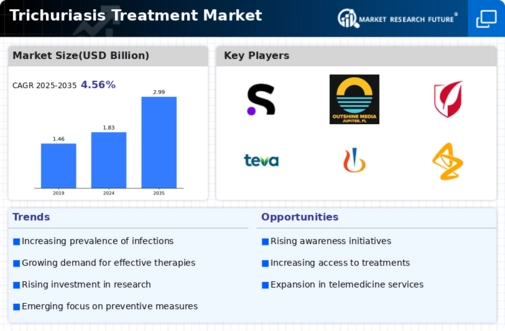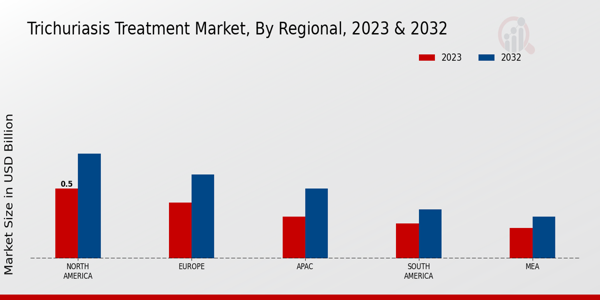Growing Awareness and Education
The Global Trichuriasis Treatment Market Industry is benefiting from heightened awareness and educational campaigns focused on parasitic infections. Public health organizations are actively promoting knowledge about the transmission, symptoms, and treatment of trichuriasis. This increased awareness is crucial in encouraging individuals to seek medical attention and adhere to treatment protocols. Educational initiatives targeting at-risk populations can lead to early diagnosis and treatment, thereby reducing the disease burden. As awareness continues to grow, it is anticipated that the market will expand, with projections indicating a market value of 2.99 USD Billion by 2035.
Advancements in Treatment Options
Innovations in pharmaceutical treatments for trichuriasis are contributing to the expansion of the Global Trichuriasis Treatment Market Industry. Newer anthelmintic drugs, such as mebendazole and albendazole, have shown efficacy in treating whipworm infections. These advancements not only improve patient outcomes but also enhance the overall treatment landscape. The introduction of combination therapies may further optimize treatment regimens, potentially increasing patient adherence and reducing reinfection rates. As healthcare systems adopt these new therapies, the market is projected to reach 1.83 USD Billion in 2024, reflecting a growing commitment to addressing this neglected tropical disease.
Rising Prevalence of Trichuriasis
The Global Trichuriasis Treatment Market Industry is experiencing growth due to the increasing prevalence of trichuriasis, particularly in tropical and subtropical regions. This parasitic infection, caused by the whipworm Trichuris trichiura, affects millions worldwide, with significant cases reported in areas with poor sanitation. The World Health Organization estimates that approximately 464 million people are infected globally, highlighting the urgent need for effective treatment options. As awareness of this disease rises, healthcare providers are likely to focus on developing and distributing effective treatments, thereby driving market growth.
Government Initiatives and Funding
Government initiatives aimed at controlling neglected tropical diseases, including trichuriasis, are pivotal in shaping the Global Trichuriasis Treatment Market Industry. Various countries are implementing strategic plans to enhance public health infrastructure, improve sanitation, and promote mass drug administration programs. For instance, the WHO's roadmap for neglected tropical diseases emphasizes the importance of integrated approaches to combat infections like trichuriasis. Increased funding and support from governmental and non-governmental organizations are likely to facilitate research and development of new treatments, ultimately contributing to market growth and improving health outcomes for affected populations.
Rising Investment in Healthcare Infrastructure
Investment in healthcare infrastructure, particularly in developing regions, is a significant driver of the Global Trichuriasis Treatment Market Industry. Enhanced healthcare facilities and access to medical services are essential for effective disease management. Governments and international organizations are increasingly allocating resources to improve healthcare systems, which facilitates better diagnosis and treatment of trichuriasis. This investment is expected to lead to improved patient outcomes and increased demand for effective treatment options. As healthcare infrastructure continues to develop, the market is likely to experience a compound annual growth rate of 4.57% from 2025 to 2035, reflecting a sustained commitment to addressing this public health challenge.






















